TraCEr facilities include the following:
Imaging
This room is dedicated to the documentation and imaging of use-wear. The emphasis is placed on 3D high-resolution techniques that allow the quantification of use-wear patterns at different scales. Thanks to the ZEISS Shuttle-and-Find and Connect software modules, the same location on a sample can be imaged several times and on different microscopes (digital microscope, confocal microscope and scanning electron microscope) quickly and easily. At the moment the lab includes the following pieces of equipment:
Zurzeit umfasst das Labor folgende Ausrüstung:
3D structured-light scanner, Aicon SmartScan-HE R8
This structured-light optical scanner can digitize the surface of samples of any size. We currently have two fields of views: 110 × 80 × 70 and 355 × 265 × 220 mm, with point-to-point distance of 33 and 108 µm respectively. The light source is a blue LED, which means that the color information (texture) is not acquired.
The acquired 3D models can then be used for archiving purposes, or to measure manually or automatically the dimensions or volume of a sample. GIS analyses can also be run on the models.
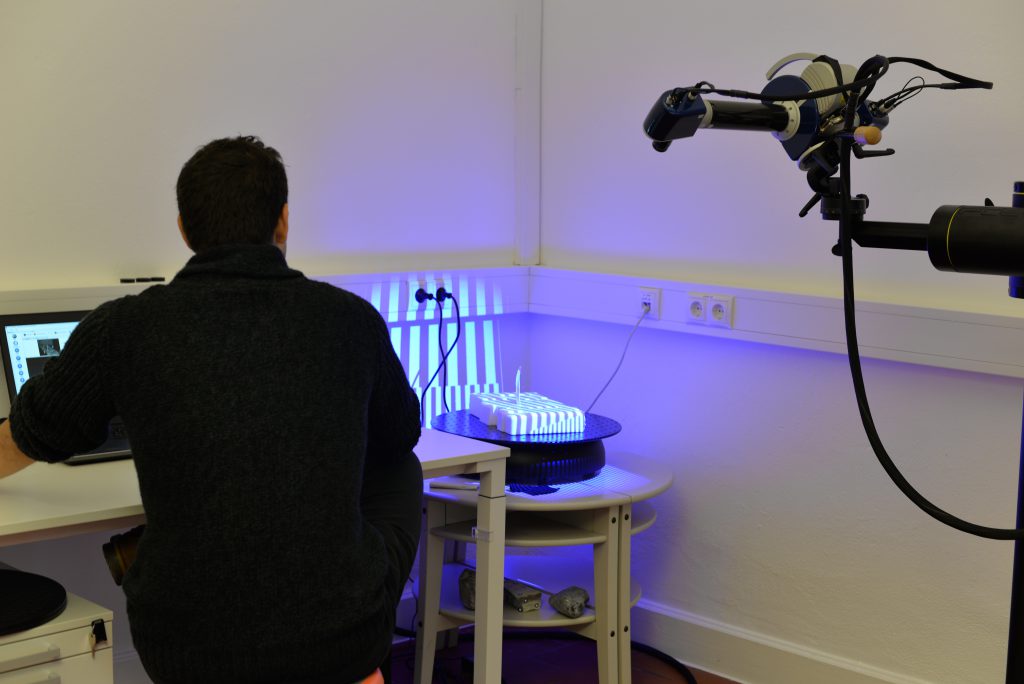
Stereo-microscope, Zeiss SteREO Discovery.V8
This stereo-microscope is used to screen samples before further analysis at low magnification (0.63×/0.116 objective with 10× oculars): Is the sample suitable for analysis? Where should we look in detail? The different light sources, its large sample height and its digital camera allow for quick characterization and documentation of almost any sample.
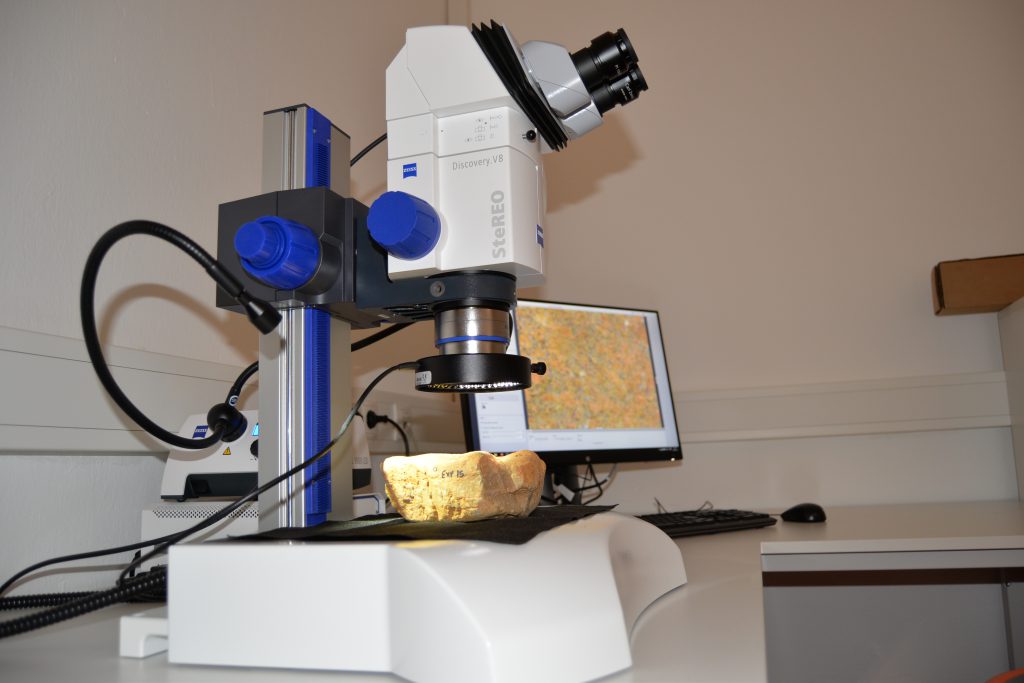
3D digital microscope, Zeiss Smartzoom 5
This digital, fully motorized microscope delivers high-quality 2D, EDF and 3D images at total magnifications ranging from 34× to 1010× for both documentation and analysis. The microscope head can be tilted so that samples can be observed from different angles without fixing the sample in unstable positions.
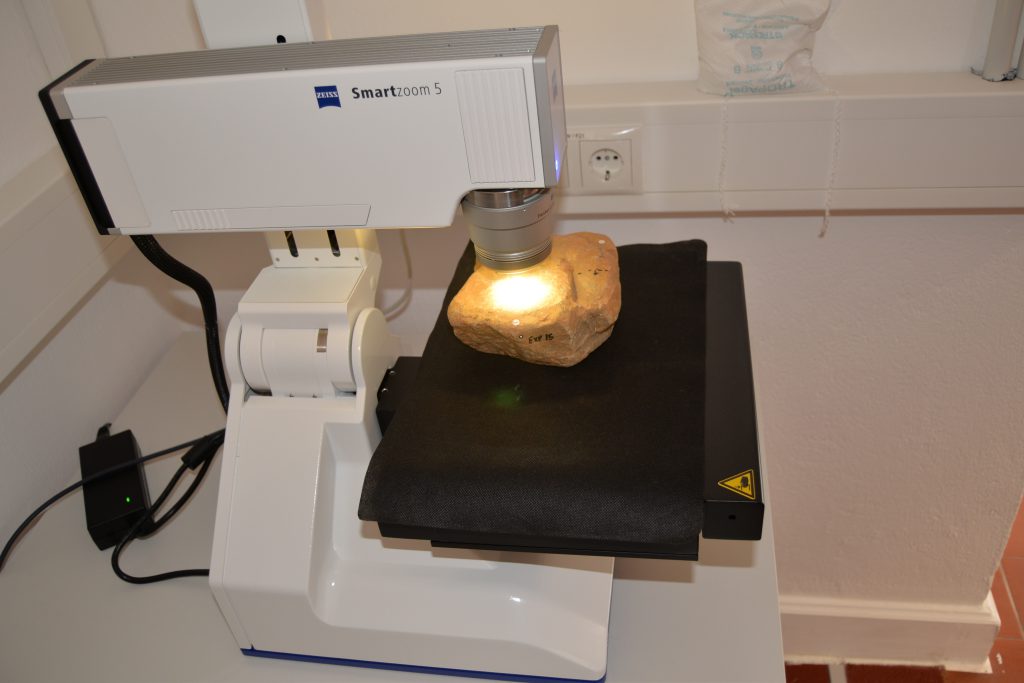
Upright light microscope, Zeiss Axio Imager.Z2 Vario, coupled to a 3D laser-scanning confocal microscope, Zeiss LSM 800 MAT
This microscope combines two pieces of equipment in one: an upright light (metallographic) microscope, and a laser-scanning confocal microscope.
The former is used to acquire an optical image of the sample (transmitted or reflected light), for example for traditional use-wear analysis, while the later provides a 3D representation of the surface at the sub-micrometric scale for the quantification of use-wear patterns. Both techniques can be applied without moving the sample so that the results of both types of analysis can be directly compared.
A choice of C Epiplan-Apochromat and LD EC Epi-plan-Neofluar objectives is available, depending on the acquisition mode and contrast methods: 5×/0.20, 10×/0.40, 20×/0.22, 20×/0.70, 50×/0.55, 50×/0.75, 50×/0.95.
Quantitative use-wear analysis is performed with ConfoMap (a derivative of Mountains by Digital Surf).
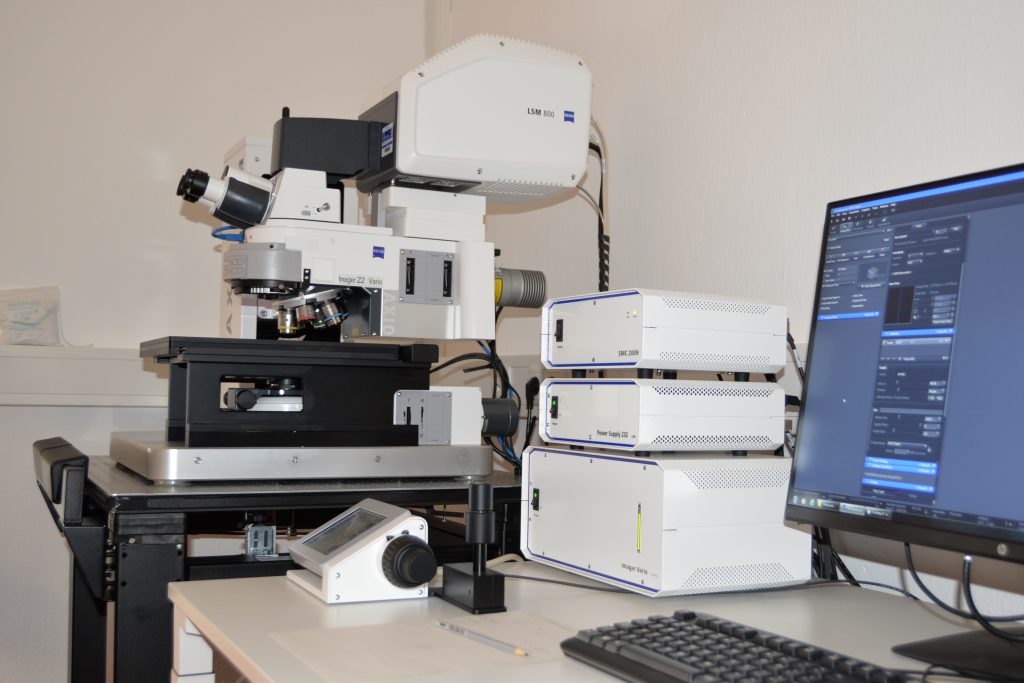
Upright light microscopes for reflected and transmitted light, Zeiss AxioScope.A1 and AxioLab.A1
These microscopes are used primarily for the traditional, qualitative use-wear analysis and for residue analysis (in situ and extracted). The metallographic, reflected light microscope AxioScope.A1 is equipped with an XY stage, a C-DIC filter and four EC Epiplan objectives (5×/0.13, 10×/0.25, 20×/0.40 and 50×/0.75). The transmitted light microscope AxioLab.A1 features four N-Achroplan Pol objectives (5×/0.15, 10×/0.25, 20×/0.45 and 50×/0.80), a rotating stage, cross-polarization and a Bertrand lens.
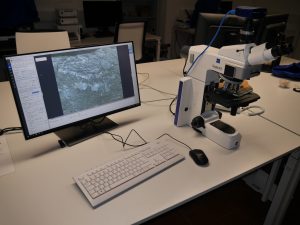
Scanning electron microscope, Zeiss EVO 25, coupled to an energy-dispersive X-ray spectroscopy detector, Bruker Quantax XFlash 6|30M
This Wolfram SEM is used for imaging at high magnification and with a large depth of field. SEM imaging is also particularly useful for highly reflective samples. The 3D surface topography can also be acquired, and analyzed with 3DSM Metrology (a derivative of Mountains by Digital Surf). Coupled to EDS analysis with the Esprit software (Bruker), the sample's elemental composition can be quantified.
This SEM features a very large sample chamber for samples up to 300 mm in diameter, 210 mm in height and 5kg. Samples can be imaged both in high and low (up to 400 Pa) vacuum. Four detectors are available: secondary electron detector (SE), secondary electron for variable pressure (VPSE G4), back-scattered electron detector (HDBSD) and energy-dispersive X-ray spectroscopy detector (EDS).
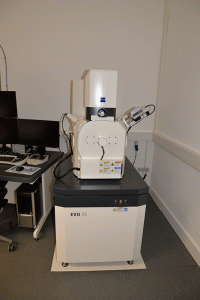
portable pieces of equipment
HP structured light 3D-Scanner Pro S2
Dino-Lite Digitalmikroskope
Zeiss Stemi 305 Stereomikroskop
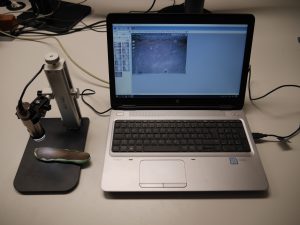
Sample Preparation
Due to its facilities, the sample preparation lab can be used to execute a multitude of tasks. Air filtered chemical storage cupboards and an active carbon filtered recirculated-air extractor hood allows for using substances classified as hazardous to health. A drying cabinet, an 80L vacuum oven, a small vacuum chamber, ultrasonic baths and an ultra-silent compressor are also available.
Experimental workshop
Experimental set-ups and their practical executions are controlled and monitored to a high degree. This is achieved by combining an industrial programmable material test-stand and measuring equipment for material properties. The experimental workshop is equipped with the following appliances:
Programmable material teststand, Inotec SMARTTESTER
The Inotec Smarttester is a programmable and modular teststand to assess functionality, as well as simulating prolonged periods of stress from usage in materials, products and components employed in the manufacturing industry. The test specimen is exposed to a defined strain or stress, which is induced with the help of actuators and controlled by sensors and an integrated control unit. In this way, wear-related phenomena (e.g. Tribology) can be observed for given raw-material pairings and quantification can be attempted with the help of 3D-imaging techniques. TraCEr is the first archaeological institution to harness the Smarttester technology.

Rock saw, Steinschleifmaschinen & Lapidary Tools LTD Goliath 450
The solidly built lapidary diamond-saw Goliath 450 features a diamond cutting disc up to 450mm diameter. It finds its use for manually cutting lithics, minerals, fossils, precious stones, glass, ceramics and bone. Depending on the nature of the cutting disc, a water/oil emulsion cooling fluid is used or plain water. The maximum cutting height is 160mm.

Diamond-Bandsaw, Exakt 310CP
The high-precision EXAKT 310 Diamond Band Saw has been developed for high-precision cutting of a wide variety of different materials and material combinations. The EXAKT 310 features a parallel guide and tailstock. Samples of different geometries can be cut using a variety of sample holders. Our model features the CP mode, i.e. the sample can continuously oscillate in different deflections. This way, the saw can produce faster and smoother coplanar cuts which, depending on the material and the grit of the diamond band used, fulfil tight surface roughness value requirements.
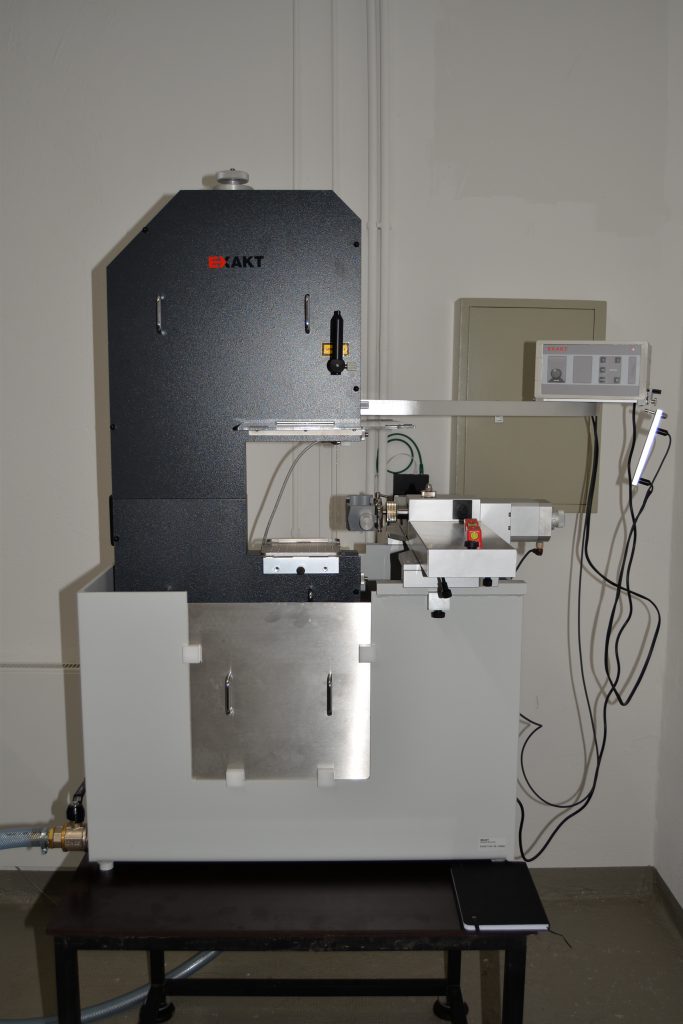
Leeb-Hardness tester, Proceq Equotip 550 + Leeb C probe
The Proceq Equotip 550 is a versatile hardness tester based on the Leeb rebound-hardness principle for on-site testing of parts. Primarily used for metallic surfaces, TraCEr is looking at the potential of the equipment to be used on other materials (rock, bone, antler, wood…). The control unit features a touchscreen and allows various exportable measuring and analysis functions. A range of measuring probes such as portable Rockwell and UCI (ultrasonic) could be connected. Presently, a Leeb C probe is available at TraCEr. The Leeb C probe features the smallest impact energy (3 Nmm) so that it can be used on small samples (≥ 500 g).

Bow and arrow teststand, Kurt Wallensteiner Hard- and Software tool for bow and arrow tests
The teststand allows to control and measure draw weight, arrow velocity and hand shock in order to carry out reproducible shooting experiments with replicas of bows and arrows from archaeological contexts.
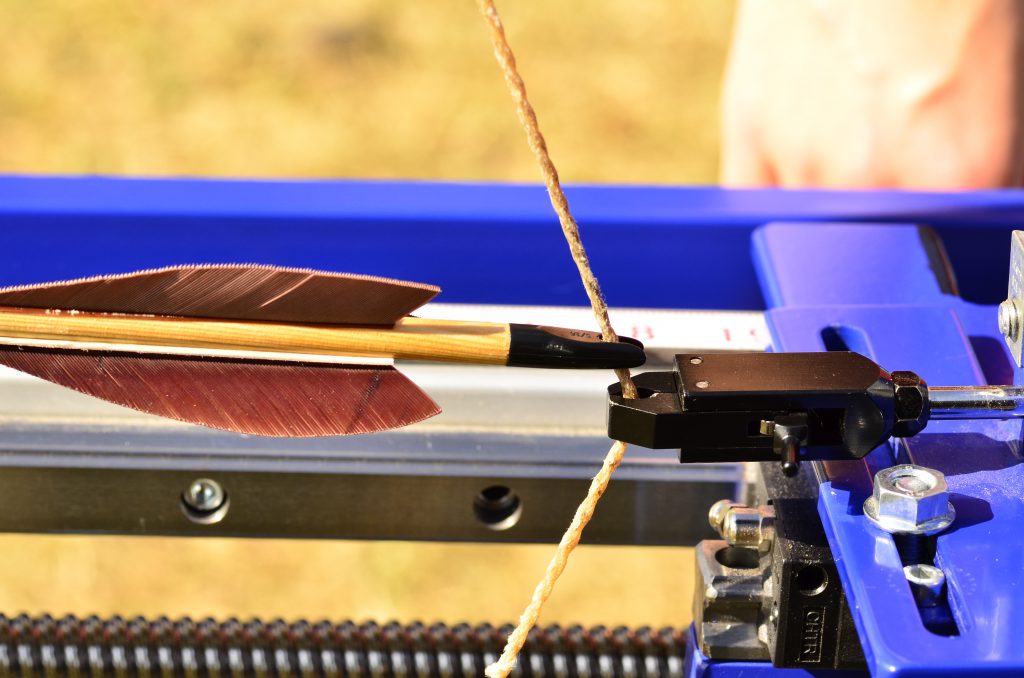
Reference Collection
Experimentally produced tools, replicas of archaeological tools, raw material samples and samples for material all form part of the reference collection. All samples are inventoried and identifiable via bar codes. The supporting data base contains the relevant information about all samples in the reference collection: Metadata (e.g. raw material, parameters for the manufacturing process or the usage, parameters for acquisition of analytical data, etc.), images, 3D-models and analytical results.